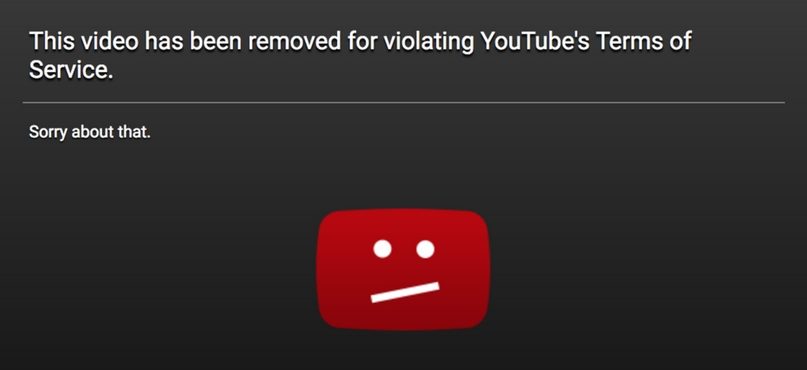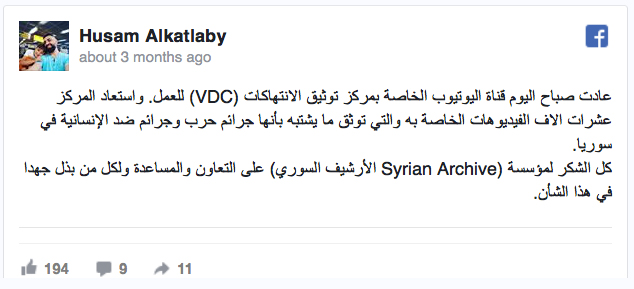By Dia Kayyali and Raja Althaibani
So much of Syria’s history has been purposefully erased by ISIS in recent years. And now, we’re seeing another erasure of history– this time on YouTube. Thousands of videos showing human rights abuses in Syria, as well as the channels that feature these videos, are being removed by YouTube. In June of this year, Google announced that they were using machine learning to detect extremist material as part of a new initiative. We started hearing about these removals, often of human rights evidence, from our partners in July, and they have increased exponentially in recent weeks. We’re working with YouTube to understand and remedy these removals, and we’re glad they’re open to trying to fix this problem– but they never should have happened in the first place.
YouTube stated in an August 1st update to Google’s June announcement that they were achieving “Better detection and faster removal driven by machine learning,” and “[o]ver 75 percent of the videos we’ve removed for violent extremism over the past month were taken down before receiving a single human flag.” We’re sympathetic to the desire to remove extremist content. But we already know that even human beings have a hard time enforcing policies around content. What’s more, the groups that we work with who have been affected by these removals exist for the explicit purpose of countering the propaganda of the Syrian regime and cataloging extremist content for use as evidence.
It’s not hard to see why videos are so important. In April, Syrian President Bashar al-Assad told media that evidence of chemical attacks, including videos, had been faked. But WITNESS partners Syrian Archive has painstakingly verified and catalogued thousands of videos that document the atrocities taking place, and even issued reports that examine and verify videos of chemical attacks and other abuses. It was the Archive that alerted us to the removals. The Archive relies on videos from a variety of sources, some of which exist only on YouTube– not all Syrian activists and media can afford an offline archive of this invaluable evidence.
And invaluable it is. As the founder of the Archive, Hadi Al Khatib, pointed out on 15 August the International Criminal Court issued its first “public warrant of arrest” that was based mostly on video evidence and social media posts about war crimes in Libya. This [type of] content might be the only evidence that would indicate if a human rights violations had happened in a specific date and location.” If there were any question that the videos being removed by YouTube, though sometimes graphic and often upsetting, have evidentiary value, that question is no longer. We must preserve these videos.
While the Syrian Archive hasn’t experienced removals directly, the Violation Documentation Center (VDC), a reputable monitor and documentation group as well as a close partner of WITNESS has lost its channel. The VDC is not new, and the fact that they post videos for the purpose of upholding human rights is not hard to verify. The VDC was established in 2011 by some of Syria’s most reputable human rights advocates, with the aim of ensuring careful and independent documentation all violations and crimes in Syria. We met VDC for the first time in 2012 following the exponential increase in video content coming out of Syria. Like many other groups working in Syria, they sought support around ensuring the effective, safe and ethical use of video documentation coming out of the country. VDC’s content, like that of many others whose channels have been taken down, has since supported the reporting and advocacy efforts of major media outlets, human rights organizations and independent investigative bodies like the Independent International Commission of Inquiry on Syria.
These videos inform human rights reporting:
“In a video interview, a local resident said that the attack had killed their 55-year-old neighbor, a woman. The Violations Documentation Center also recorded that toxic gas had killed an unidentified woman in Aleppo on November 23. Syria Civil Defense reported the following day that toxic gases had killed one woman in Aleppo. The woman may have been killed in the November 23 attack, since there were no reported chemical attacks on November 24.” — HRW report – “Syria: Coordinated Chemical Attacks on Aleppo”
So when the VDC channel, which houses over 32,000 videos of the conflict was taken down – we grew increasingly concerned. The good news is that the VDC announced that they were able to regain access their channel and videos, however their channel remains closed to the public. In a Facebook post published by VDC’s Husam Alkatlaby, he goes on to explain that they were able to recover tens of thousands of videos documenting suspected war crimes and crimes against humanity in Syria and he thanks their allies at Syrian Archive for their support and help on the matter.
“We believe everyone should have easy, open access to information and that video is a powerful force for education, building understanding, and documenting world events, big and small.” – YouTube
We agree that YouTube has an incredibly important role to play in the fight for justice and human rights in Syria. As Keith Hiatt, Vice-President of non-profit human rights software developer Benetech told the New York Times, “Some have risked their lives, others have given their lives to document the atrocities and document human rights violation.” If YouTube takes these videos down, we could lose “the richest source of information about human rights violations in closed societies.”
WITNESS has and will continue to advocate with YouTube to improve its policies in a way that supports human rights users. These decisions are especially important because while policies can uplift human rights, they can also accidentally undermine them. We are working with YouTube to understand what is happening, and we’re glad that so many videos have been restored. But there are still new takedowns happening every day. We join with others working for human rights in the Syrian conflict to express increasing concern about Youtube’s new machine learning technology. As members of the global human rights and tech community, we urge YouTube to reevaluate their new system.
The takedown of critical channels like VDC doesn’t just make the search for justice for Syrians more difficult. It is in fact counterproductive to the fight against terror and extremism. These channels represent organizations that are lauded for leading the fight against terror and extremism with technology.
YouTube’s commitment to fighting terror and extremism through their platform also requires that they produce technologies that will aid, not deter critical human rights leaders from providing access to invaluable documentation and evidence of crimes in one of the most heavily documented conflicts in history today.
Dia Kayyali is an activist, writer, and attorney, and fights for freedom of expression online, especially on social media platforms. Follow on Twitter: @DiaKayyali
Raja Althaibani is the Middle East and North Africa Program Coordinator of Witness.org. Follow on Twitter: @RajaAlthaibani
This article was originally published on Witness.org website. Republished here with permission.

